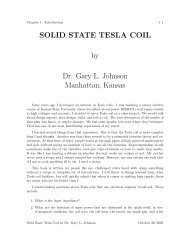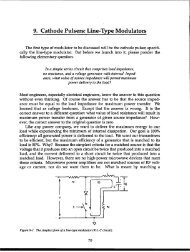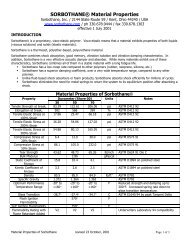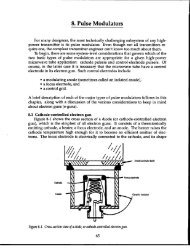3.6M north10.pdf - Dean-O's Toy Box
3.6M north10.pdf - Dean-O's Toy Box
3.6M north10.pdf - Dean-O's Toy Box
You also want an ePaper? Increase the reach of your titles
YUMPU automatically turns print PDFs into web optimized ePapers that Google loves.
Cathode Pulsers: Hard-Tube Modulators (10) 147<br />
plied to a grid is positive with respect to the cathode, some electrons will be<br />
intercepted. (This is almost always true for the screen grid and, in a high-power<br />
gridded tube when full current is being demanded, for the control grid as well.)<br />
One of the goals of tube design is to minimize the control-electrode current<br />
because it serves no useful purpose and subtracts from the current that can be<br />
useful. The total cathode current in a tetrode can be expressed as:<br />
I =<br />
cathade I anode + lco.troIgrid + Is.reen grid = ‘:’<br />
where K is the effective perveance. K can also be evaluated as<br />
~= 2.33x 10+(A)c<br />
(Sdiade)’ ‘<br />
where A is the cathode emitting area in cmz, c is a constant dependent on tube<br />
geometry, S~l~e is the equivalent diode spacing and given in cm, and V is the<br />
effective voltage. The fractional exponent 3/2 applies to most tube geometries.<br />
Effective voltage can be further defined as<br />
v v<br />
v=Vcontro,tnd + ““en “d +J=-,<br />
where Psg and ~ are the amplification factors of the semen grid and anode,<br />
respectively.<br />
The perveance of electron tubes can vary from less than 10~ perv., or 1 ~perv<br />
(the equivalent to 1 pA/V3t2), for a high-performance millimeter-wave TWT, to<br />
0.01 perv, or 10,000 ppervs (the equivalent to 0.01 A/@JZ), for a large, gridded<br />
power tube. The screen-grid and anode amplification factors, or p~g and ~, are<br />
factors that quantify the strengths of the electric-field contributions at the cathode<br />
produced by voltages applied to screen grid and anode as they relate to the<br />
electric field produced by the control grid. If, for instance, a tetrode had a screen<br />
amplification factor of 10, it would require a change of screen-grid voltage 10<br />
times as great as that of the control grid to have the same effect on cathode<br />
current change. Similarly, if the anode amplification factor were 100, the change<br />
in anode voltage would have to be 100 times as great as the change in controlgrid<br />
voltage for the same cathode-current change. The screen-grid and anode-p<br />
factors reflect the facts that not only are the screen grid and anode farther away<br />
from the cathode than the control grid, but the field produced by voltage on the<br />
screen grid must penetrate the shielding effect of the control grid, and the field<br />
produced by voltage on the anode must penetrate the shielding effects of both<br />
grids. We can see, then, that for positive voltage applied to both screen grid and<br />
anode, there will be a negative voltage that, when applied to the control grid, will<br />
cancel the field-strength contributions of the others and result in no current leaving<br />
the cathode. This balance point is called the cut-off grid bias for a given<br />
Psg<br />
Pa







